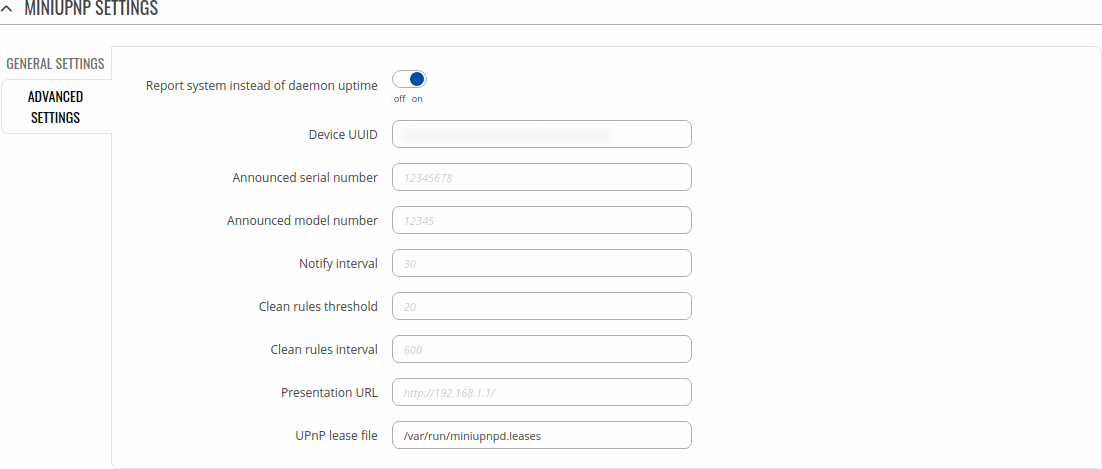OTD500 UPNP
The information in this page is updated in accordance with firmware version OTD500_R_00.07.19.4.
Summary
UPnP (Universal Plug and Play) is a service that allows clients in the local network to automatically configure some devices and services.
This chapter of the user manual provides an overview of the UPnP page in OTD500 devices.
Note: UPNP is additional software that can be installed from the System → Package Manager page.
Active UPnP Redirects
The Active UPnP Redirects sections allows you to manage currently active UPnP redirects.
MiniUPnP Settings
General Settings
| Field | Value | Description |
|---|---|---|
| Enable | off | on; default: off | Turns UPnP on or off. |
| Use secure mode | off | on; default: on | Turns secure mode on or off. |
| Enable additional logging | off | on; default: off | Puts extra debugging information into the system log when enabled. |
| Downlink | integer; default: 1024 | Bandwidth available for traffic coming in from the external interface in kilobytes per second. Note that this only information given to clients, it doesn't control the speed. |
| Uplink | integer; default: 512 | Bandwidth available for traffic out the external interface in kilobytes per second. Note that this only information given to clients, it doesn't control the speed. |
| Port | integer [1..65535]; default: 5000 | Port to listen for incomming requests. |
Advanced Settings
| Field | Value | Description |
|---|---|---|
| Report system instead of daemon uptime | off | on; default: on | If enabled, system service uptime is reported. |
| Device UUID | string; default: unique | The Device UUID attribute specifies and uniquely identifies a device that supports Universal Plug and Play (UPnP). |
| Announced serial number | string; default: none | Specifies serial number for XML Root Desc. |
| Announced model number | string; default: none | Specifies model number for XML Root Desc. |
| Notify interval | integer; default: none | Interval in which UPnP capable devices send a message to announce their services. |
| Clean ruler threshold | integer; default: none | Minimum number of redirections before clearing rules table of old (active) redirections. |
| Clean ruler interval | integer; default: none | Number of seconds before cleaning redirections. |
| Presentation URL | string; default: none | Presentation url used for the Root Desc. |
| UPnP lease file | string; default: /var/run/miniupnpd.leases | Stores active UPnP redirects in a lease file (specified), like DHCP leases. |
MiniUPnP ACLs
ACLs specify which external ports may be redirected to which internal addresses and ports.
There are two preconfigured rules, one to allow high ports, and another to deny the rest. Highest priority is at the top of a list and goes down. To add another specific rule, click the 'Add' button.
| Field | Value | Description |
|---|---|---|
| Comment | string; default: none | Adds a comment to this rule. |
| External ports | integer [0..65535] | range of integers [0-65535]; default: none | External port(s) which may be redirected. May be specified as a single port or a range of ports. To specify a range use a dash ('-') symbol between two integer numbers. |
| Internal Addresses | ip/integer [0..32]; default: none | Internal address to be redirect to. |
| Internal ports | integer [0..65535] | range of integers [0-65535]; default: none | Internal port(s) to be redirect to May be specified as a single port or a range of ports. To specify a range use a dash ('-') symbol between two integer numbers. |
| Action | allow | deny; default: allow | Allows or forbids the UPnP service to open the specified port. |




